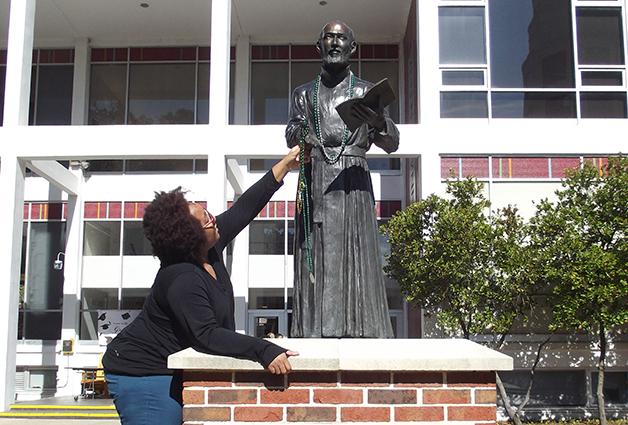Jesus, the reason for Mardi Gras season
Bethany Washington, business junior, gets the St. Ignatius statue in the Mardi Gras spirit with some beads. Mardi Gras season is not just about the parades and throws, it also contains religious symbolism.
February 5, 2015
Mardi Gras, or Fat Tuesday, didn’t emerge from a long line of parades and coconut tossing, but from deep-rooted Catholic traditions.
A last hurrah before Lent, a forty day period of fasting, Mardi Gras is also known as Carnival which comes from the Latin words “carne vale” meaning farewell to flesh.
Kurt Bindewald, director of university ministry, said Lent plays a large role in the festivities of Mardi Gras season.
“The reason why it’s called Fat Tuesday or Mardi Gras is that people kind of get all the partying and stuff out of their system before the time of fasting and penance of Lent. So naturally, that involves a lot of food and drink,” Bindewald said.
Carnival season starts soon after Epiphany, the twelfth night after Christmas. It is the recognition of when the wise men arrived to see baby Jesus and pay him homage by bringing gifts.
Wayne Phillips, curator of Carnival Collections at the Louisiana State Museum, said that in 18th and 19th century New Orleans, the celebration of Mardi Gras was focused around the king cake.
“It turned into a tradition where the parties and the balls would be accompanied by the presentation and serving of a cake, what we would call a king cake today,” Phillips said.
The king cake’s religious meaning is not only shown by the shape — the circle representing the wise men’s journey — but through the colors as well. Purple represents justice, yellow equates to power and green stands for faith.
“The tradition developed putting a bean and, eventually, a small baby figurine inside the cake,” Phillips said. “Whoever found that in the cake would be declared king of the ball and that, of course, left the baby as a tradition of bringing the next king cake.”
The baby figurine in the cake became a symbol for finding baby Jesus.
“Particularly in New Orleans, because of its deep and long Catholic tradition, there’s a lot of evidence why it sort of takes on a religious connotation,” Bindewald said.
Mardi Gras was introduced in Louisiana when the French established their first permanent settlement and brought the festivities with them.
C.W. Cannon, English and New Orleans studies professor, said that like New Orleans itself, Carnival was not designed as a tourist attraction.
“There is a huge degree of resident participation in Carnival and a huge range of traditional practices, many of which have never been discovered by tourists.”
Bindewald said Mardi Gras became something the city and families celebrated together.







